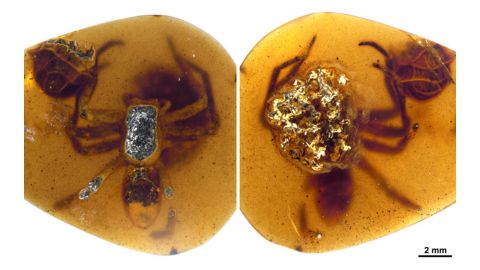99 million-year-old spider mummies reveal moms cared for teeny spiderlings– very interesting reveal! How were the spiders preserved?
The following written content by Laura Geggel

The spiders were preserved in amber.
Big-eyed spiders were likely guarding their egg sacs and possibly caring for already hatched spiderlings when they were trapped in sticky tree resin some 99 million years ago. That resin hardened, locking up those arachnid mamas in four chunks of amber recently mined in Myanmar, and now considered the oldest evidence of maternal care in spiders, researchers say.
Although the finding isn’t unexpected, given that many spider mothers care for their offspring nowadays, “it’s lovely to have actual physical evidence through these little snapshots in the fossil record,” study co-researcher Paul Selden, a distinguished professor emeritus of the Department of Geology at the University of Kansas, told Live Science.
Of the four amber chunks, the most extraordinary is a piece holding a large female spider with part of an egg sac under her, Selden said. This spider’s facial appendages, spineless legs and trichobothria, or “sensing hairs,” indicate that she is a member of the Lagonomegopidae family, a now-extinct group of spiders that lived in the Northern Hemisphere during the Cretaceous period (145 million to 66 million years ago). The mother’s protective stance over her egg sac is suggestive of maternal care, Selden said.
“The female holding onto an egg sac with little tiny spiderlings inside — that’s exactly the position that you would find female spiders guarding their eggs,” which may have also helped to keep the eggs warm, Selden told Live Science. “So, it really is a typical female spider behavior caught in an instant by this fossilization process.”
The amber even preserved the silk thread that wrapped the spider’s eggs together. Some scientists think that spiders originally used silk to bundle their eggs together, and then later used it for other purposes, such as webs, Selden noted.
One of the amber specimens with hatchlings contains spider silk entwining pieces of detritus, which may have been part of a nest that the mother built to guard her egg sac. This suggests that the hatchlings stayed with their mom in the nest after hatching, rather than immediately dispersing, the researchers said. Read more from Live Science.





